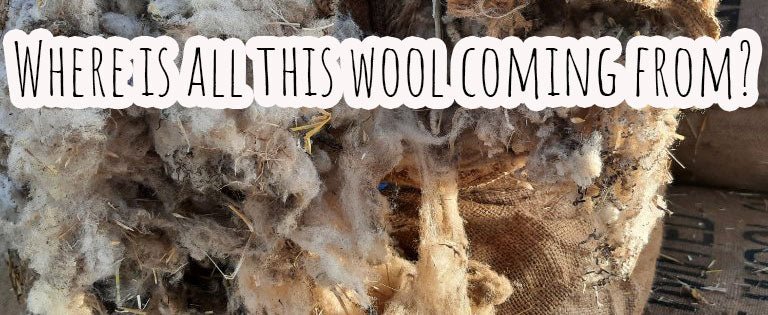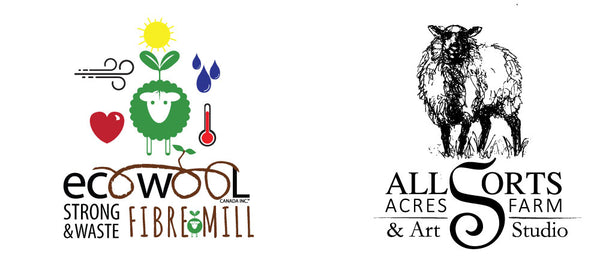
Where is all this waste wool coming from? The importance of closing the loop on wool in Canada
Share
In the autumn of 2008, an unexpected gift of two Shetland sheep began my shepherding journey. Although the move to an acre homestead had initially featured goats at the centre of the plan, the sheep were free and they needed a home, so they stayed. Little did I know that those two fuzzy critters would be the reason I would have a barn full of raw wool 15 years later.
The following spring, the sheep needed to be sheared. Wow, what a job. An experienced local shearer came to our little farm and before we knew it, the wool was off of Itchy and Scratchy. Boy did they do both after their haircut!
Sheep shearing is a complex dance that appears easy, but isn’t. It’s hard, dirty, tiring work that breaks backs and takes off fingers. One after the next, the sheep must be wrestled (if they are young and new to it) or persuaded (for the seasoned ewe) to shear their fleece and relieve them of 6 months’ worth of wool – about 6 lb (2.7 kg) on average. After the spring shearing, the sheep seem confused, but then frolic like lambs at being released from their fuzzy coats.
I had gone into this with a bit of idealism that all of our wool would be not only usable, but wanted – boy was I wrong. Shepherds’ options are:
After 15 years of sheep farming, co-founding the first International Fibreshed Affiliate, hours of hands-on research, reading books and papers from across the world, poking through history, and talking with other sheep farmers, I realized that unfortunately a very small amount of sheep wool in Canada is actually used to produce… well… anything. The reality is that, by our best estimate, less than 3% of sheep wool in Canada is appropriate for clothing, or any other use, including industrial. Even the better wool isn’t processed due to lack of demand and processing capacity, both in Canada and internationally.

This was disappointing to say the least. On top of being unable to sell my wool, I hated to be producing more waste in a world full of ecological issues. I only have so much acreage to dump that wool on! Surely there was another solution for this once valuable material.
Being the tenacious, some would even say ‘stubborn’ type, I kept seeking solutions and talked to everyone I could about using waste wool - from other farmers to government officials. Although the ideas and concepts were vast and viable, it wasn’t until the Support of COIL (Circular Opportunity Innovation Launchpad) in Guelph that EcoWool Canada Inc. truly came to life. It is the shared vision of having non-food agricultural and organic waste given back to the land from where it came.
I want to share some of what I’ve learned, and what inspired me to create a whole new enterprise to address the enormous amount of waste wool we have in Ontario, Canada, and the world.
If you love the circular economy and systems thinking and would be excited to learn about a circular solution to a huge waste problem, then this blog post is for you!
A huge thank you to Julianna Van Adrichem at Promosaurus for creating a concise history of wool through recent history.
The ‘shear’ drop in global wool demand
Wool has historically been a valuable natural fibre, with many uses – from warm clothing to upholstery stuffing. It was one of the first commodities to enter international (with Europeans’ involvement) trade, and from the 17th to the first half of the 20th century, wool textiles were a leading global industry (1).
However, in the mid-1900’s things began to change as fierce competition from synthetic fibers caused the demand for woolen products to drop dramatically. This, of course, led to a plummeting of raw wool’s market price to below the cost of shearing and transportation (2).

Other factors also affected the demand for wool. As the market for textile grade wool dropped, farmers switched to breeds that were better for meat - the tradeoff being that their sheep grew rougher, scratchier wool containing a lot of kemp (coarse fibres), making it practically unusable for textiles, but still needing to be sheared regularly for the animal’s welfare (3, 4). Furthermore, a lack of potential buyers even for high grade wool, and a lack of infrastructure for collecting, washing, and trading that wool are making the industry economically unsustainable (1, 4).
In the EU, with the exception of small, specialized wool grown for boutique handicraft or felting products, the vast majority of the coarse wool produced annually is wasted. It is not even economical to ship it to Asian countries that would use it (4).

Knots of waste wool
Out of the 1,977,300,000 kg of global wool “produced” in 2022, approximately 200,000,000 kg are high-grade, Merino wool (5), another 125,000,000 kg of wool are suitable for other apparel such as sweaters and coats, 175,000,000 is used for interiors such as carpets and upholstery, BUT, the rest of the 1,477,300,000 kg of wool is out there somewhere. Mostly being stored on farms, compost piles, being burned, or landfilled. This happens each and every year (7).
Further, “wool produced annually” only reflects the traded wool, which enters the textile industry. The statistics don’t include raw wool that doesn’t leave sheep farms or that goes to landfill. Because of this, it is very hard to accurately determine just how much waste wool there is in the world.

Additionally, the wool supply chain produces huge amounts of waste at each stage: carding, combing, spinning, and weaving (8). This has become an issue for solid waste management, with the disposing of huge quantities of wool in bulk becoming an environmental and health concern (1, 8, 9).
Most of the stats I’ve mentioned are from before COVID. Unfortunately, COVID didn’t help. The market for wool dropped, shipments dropped, and the amount of waste increased (10).
Whether the wool will be sold or not, regular shearing is required for sheep health, so farmers continue to shear their sheeps’ wool for their welfare with no profit in sight (1,3).
Baaaaad news for Canadian Wool Production:
Canada might not be included in the pie chart above, but we are very much a part of this picture.
As the demand for Canadian wool fell over the last 75-ish years, Canadian sheep farmers turned to breeds that are better for meat, which, like our EU counterparts, produce lower quality wool. This increased the amount of waste wool here in Canada.
Currently, we are still dealing with the aftereffects of COVID on global trade. This meant a significant drop in demand for our wool and lower prices, especially since newly sheared wool is always ready to come on the scene (10)!
China has historically been a main market for Canadian Wool, but very stringent COVID mandates and extreme heat due to climate change has led the government to closing production hours by up to 2 days per week. As a result, they have been buying less and less of our wool (10).

In the past we did use our wool and made some amazing things from it. What has happened now is that we have lost our wool processing infrastructure. We used our wool for blankets, stuffing, mattresses, carpets, and so much more. but to do that a large manufacturing base and a skilled labour force is needed. From scouring (washing) mills to spinning and weaving mills they are all gone. Left are the brave and pioneering mini-mills that take fleeces from small flocks, processing it for handmade markets. These mills are reinventing our fibre landscape, but they can’t do it alone. They are backed up, couldn’t, and wouldn’t want to take most of the wool that’s out there. We need that fibre manufacturing base back.
Waste wool? Not by my watch!
Even though wool is getting more attention as people become critical of the widespread pollution caused by the use of synthetic textiles, there will still be lots of waste wool for the foreseeable future (10).
But, we’re here to stop that wherever we can.
Wool makes an incredible soil amendment. By pelletizing it for use in agricultural or small-scale gardening, we close the loop on wool, returning the nutrients to the soil locally to improve farm fertility. Take a look at our last blog post about the benefits of wool pellets to soil, everything from deterring snails to increasing soil porosity.

Conclusion
We may have had a rude awakening during our first shearing in 2007, but our journey to turn Ontario’s wool into a valuable resource is thoroughly fulfilling!
So far, we’ve produced several loads of EcoWool pellets, and once we really get rolling we will have the capacity to process about 50,000 kg/year. We are so excited to make a dent in the growing pile of waste wool in Ontario and to turn it into a fertilizer with so many benefits to the soil and environment!
So, what do you say? Excited to get our wool pellets into the garden? We sell pellets in a range of quantities, from 700 g bags, perfect for container growing, to 10 kg bags for 200 to 250 square foot fields. Check out our store now! There is a 15% discount for first-time buyers!
Now that you know how much wool is just sitting around, underutilized, and how exceptional it is for soil, it seems so obvious to feed it to our plants, doesn’t it? I mean, what's better than bringing a waste product full-circle, into a valuable and productive product that provides a laundry list of benefits in the process? I’m biased, but I’m going to say… not much.

Sources
-
Rajabinejad, H., Bucişcanu, I.I., Maier, S.S. “Current approaches for raw wool waste management and unconventional valorization: a review.” Environmental Engineering and Management Journal. 18:7, 1439-1456. (2019) https://www.researchgate.net/publication/324866415_Current_Approaches_For_Raw_Wool_Waste_Management_And_Unconventional_Valorization_A_Review
-
USDA. “Sheep, Lamb & Mutton: Sector at a Glance: U.S. Production” (2020) https://www.ers.usda.gov/topics/animal-products/sheep-lamb-mutton/sector-at-a-glance/
-
Bradshaw, Terence, and Kimberley Hagen. "Wool Pellets Are a Viable Alternative to Commercial Fertilizer for Organic Vegetable Production." Agronomy 12.5 (2022): 1210. https://www.mdpi.com/2073-4395/12/5/1210
-
Zoccola, M., Montarsolo, A., Mossotti, R., Patrucco, A., Tonin, C. “Green Hydrolysis as an Emerging Technology to Turn Wool Waste into Organic Nitrogen Fertilizer” Waste and Biomass Valorization. 6, 891–897 (2015). https://link.springer.com/article/10.1007/s12649-015-9393-0
-
Expert Market Research “Global Merino Wool Market Outlook“ (2023). https://www.expertmarketresearch.com/reports/merino-wool-market#:~:text=The%20global%20merino%20wool%20industry,forecast%20period%20of%202023%2D2028
-
Parlato, M.C.M., Porto, S.M.C., Valenti, F. “Assessment of sheep wool waste as new resource for green building elements”. Building and Environment 225. (2022) https://www.sciencedirect.com/science/article/abs/pii/S0360132322008265
-
IWTO. “Wool Production, International Wool Textile Organization.” (2015) https://www.iwto.org/wool-production
-
Sharma, S. C., A. Sahoo, and Roop Chand. "Potential use of waste wool in agriculture: an overview." Indian Journal of Small Ruminants (The) 25.1 (2019): 1-12. https://www.researchgate.net/publication/332192930_Potential_use_of_waste_wool_in_agriculture_An_overview
-
Zheljazkov, Valtcho D., et al. "Wool-waste as organic nutrient source for container-grown plants." Waste Management 29.7 (2009): 2160-2164. https://www.woolwise.com/wp-content/uploads/2017/05/03.2-The-Wool-Fibre-and-its-applications-Notes.pdf
-
Canadian Co-operative Wool Growers Limited. “Wool Market Reports” (2022) https://www.wool.ca/page/wool-market-reports
-
Statistics Canada. “Number of sheep and lambs on farms (x 1,000).” (2023) https://www150.statcan.gc.ca/t1/tbl1/en/tv.action?pid=3210012901
